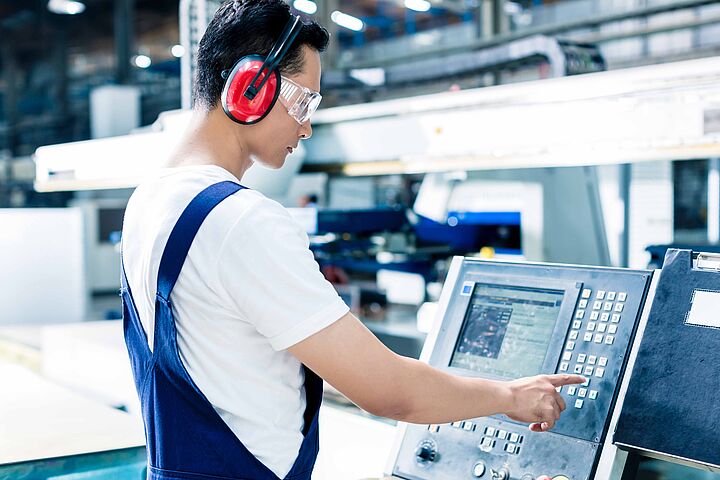How a manufacturing software can help companies with a safer return to work during COVID-19?

test - where?
Manufacturing software and shop floor data capture applications can assist small and midsize companies get back to being productive while protecting employees from COVID-19 infections
by Ana Bracho
As Covid-19 is spreading around the world, manufacturing companies are challenged with keeping their workplace safe and free of any illness.
In a survey done by the US National Association of Manufacturers (NAM), reveals that 78.3% of respondents say that the COVID-19 outbreak is likely to have a financial impact on their businesses; 53.1% of manufacturers are anticipating a change in their operations in the coming months; and 35.5% say that they are already facing supply chain disruptions.
In manufacturing environments, shop floor teams are often required to register work times and material transactions.
Many data capture systems are also located in terminals shared by several users, which increases the risk of transmission of viruses, germs, or bacteria.
Therefore, manufacturing firms can ensure that the workplace is safe for employees by closely monitoring and protecting their workforce.
Our suggestions to reduce unnecessary contact between employees on the shop floor include:
1. Replacing Shop Floor Desktop Terminal with Web Terminals
Manufacturers should replace the desktop terminals with web terminals and provide individual devices for each employee to avoid spreading germs.
Desktop terminal are accessed simultaneously by multiple people. Increasing the risk of an infection. Also keeping it clean and sterilized takes time.
Web terminals can be access via industrial handheld devices, as well as, from a simple smartphone or tablet. Your employees can capture data safely.
Therefore, manufacturing companies should provide each of their relevant employees a designated device.
Additionally, the use of web terminals facilitates data entry or transactions from any site of the company.
Beas Manufacturing, a leading manufacturing software for small and midsize manufacturing businesses, is equipped with specific data capture applications to support the use of Web Terminals. You have the possibility to capture:
Capture Work order transactions:
Including the following transactions:
- Work order start and stop
- Time receipt
- Production goods issues and goods receipt
- Work order backflushing and start/stop interruptions.
Inventory data:
Including the following transactions:
- Inventory History report
- Batch/Serial information
- Warehouse Stock
Stock transactions: Including Goods issue, Goods receipt, Goods receipt PO, Stock transfer and Stock transfer request.
And more.
Why should you start using Beas Manufacturing Web Terminal in your manufacturing business?
- Does not require client installation, easy configuration
- Multi-language and configurable by user
- Available in Android, iOS mobiles or Desktop PC using a browser
- Responsive apps, adapting information according to the screen size
- Better usability with GS1-128 support
- Support on multiple lines, batches and serial numbers for the same document
- Faster and more simple way to register information
- SAP Business One and WMS bin warehouse support
If you’d like some more information on Beas Manufacturing data capture solution you can watch this.
You can get further information about the Beas WebApps Terminal 2.1 in the overview video on YouTube or by checking out to online documentation.
2. Integration of Your Manufacturing Solution with Automated Equipment
Another way a manufacturing business can ensure that the workplace is safe for employees is by automating the time registration of products manufactured. This can save manufacturing companies a lot of time and money and also increase their productivity.
However, too often, manufacturers are not integrating their ERP or Manufacturing solution with the shop floor PLC (Programmable Logic Controller), which controls the operation of the machinery. Most of the time, it’s because the time and effort it takes to create the integration.
PLC systems do not store data.
They always display the data collected in real time. That means, you cannot get reports from PLC and that means losing insightful data of your manufacturing operations.
As a manufacturer, you can begin to take advantage and integrate your PLC to your manufacturing software to report production times or to automatically report material consumption, set up and cycle times, time per job and other important data.
Automating the processes not only reduces manual interaction but also makes it more reliable by eliminating manual errors and reducing effort dedicated to time registration.
Beas Manufacturing is a manufacturing solution that facilitates this integration is two ways.
1. By using the Data Integration Hub in conjunction with the scheduled tasks
The Data Integration Hub is a tool that imports data to Beas Manufacturing, including data validation and creation of transactions. The following information can be imported using Data Integration Hub:
- Item master data and manufacturing structure as BOM and routing
- Various Beas master data as Resources, Work orders
- Work order transaction data: work hours, receipts
- Other Transactions: attendance
You can find further information about the Data Integration Hub in the Beas Manufacturing Documentation.
2. It can be programmed using the Beas Service Layer (BSL)
The BSL is allowing different communication through ODATA.
For companies that prefer programming their integration or need to manage from other systems, this can be covered by using the Beas Service Layer.
The Beas Service Layer provides a uniform way to expose full-featured business objects on top of highly scalable, high-availability applications.
The Beas Service Layer is a new generation of extension API for consuming Beas and SAP Business One data and services.
It builds on a core protocol of HTTP and OData, but you can also use it with Beas script, macro script, or PowerBuilder.
Watch this video to understand how you can integrate your applications using the Beas Service Layer.
We wish everyone a safe return to work, and enthusiasm on the way back to normalcy.

